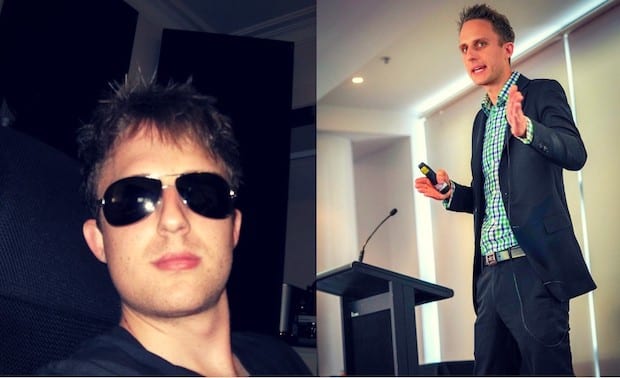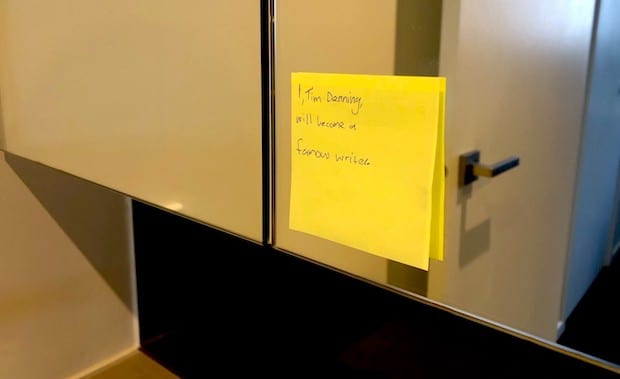Success Advice
How A 19 Year Old Kid Got The Chance To Work For Gary Vaynerchuk

“Crazy things happen when you know who you are. Certainty breeds influence”
This is the story of a new buddy of mine named Swish. I met him over Skype when my friend Joel Brown told me that we should chat. Within minutes of having a phone call with young Swish, I saw something quite incredible.
I couldn’t quite put my finger on it, but I knew that this chance encounter was going to change the way I think. As I got to know Swish through the few Skype calls I had with him, I learned something about him that blew my mind:
Swish had been headhunted to join Gary Vaynerchuk’s team in New York.
This is no small achievement. Gary is one hell of a successful man, and there are not too many people that haven’t read one of his books or listen to The Ask Gary Vee Show. His book “Jab Jab Jab Right Hook” changed the way I thought about asking my followers to do stuff.
So how did a 19-year-old kid get the chance of a lifetime? Read below.
1. Age means jack sh*t
Use your weaknesses to your advantage. Being nineteen could be perceived as a weakness. You have little life experience and are still finding your place in the world. Swish didn’t care about his age. He let his passion and enthusiasm light up the world.
The kid has infectious charisma and his certainty breed’s influence. He may not have all the answers at age nineteen, but he certainly doesn’t let you think that. Swish has started more businesses at nineteen than most people start in a lifetime.
He has a wearable tech company that is looking to change the game within the sports industry. Most people thought he was crazy and despite that Swish didn’t listen to them.
2. Surround yourself with winners
Swish didn’t have the contacts to get his wearable tech company into the NBA initially. What did he do? Hired Trevor Booker from the Brooklyn Nets NBA team to join his advisory board. You don’t need all the contacts; you just need to bring the right people with you on the journey.
3. Hustle harder than anyone else
Swish spends lots of time on social media. In the early days, Swish built connections with a few key people on Gary Vaynerchuk’s team via social media. He regularly tagged them in relevant posts. He shared his content with them.
What Swish did that very few do is hustle harder than anyone else. He’s a nice guy at his core so when he asks you to do something you feel compelled to hear him out. Swish is too cool and too nice to ignore. People are drawn to the guy because of who he has become.
He’s the kind of guy that everyone wants as their brother. I’ve often wondered what makes the difference between success and failure. People like Swish have shown me time and time again that it’s a strong work ethic, combined with an infectious human character.
Beautiful people on the inside are not the type of people to be lost in a crowd. Their spirit shines through and that’s what makes them get the results we all want. Swish getting the chance of a lifetime is no accident. It’s not chance. It’s not good fortune. It’s hustle.
4. Back yourself when no one else will
If you go back two years, most people hadn’t heard of Swish. He was unknown and finding his way in a sea of social media influencers. This didn’t stop Swish from following his dream. Fundamentally, like me, Swish is an entrepreneur.
He wants to make the world a better place through his various business pursuits, speeches and content. He’s cast a pretty wide vision and he achieves goals every single day that gets him towards his ideal life. People are drawn to that vision.
A vision for change and a vision for the future is what we all want. The trouble is there aren’t too many people that are bold enough to dream up a vision like this and then execute on it. I believe Swish is one of those people who will achieve the impossible.
There’s no way someone with that much guts can’t influence the right people to bring on the journey. Swish can’t achieve his goals alone and he knows that.
He’s taken the first step though which is backing himself above all else. He believes in himself and so it’s only natural that we will all start to believe too.
5. You have no freaking idea how powerful social media is
I think sometimes we forget the age we are living in. With enough patience, we can literally get in contact and build a relationship with anyone we want. A friend of mine said to me that this idea is limited. He said to me, for example, that if I want to get in touch with Tony Robbins via social media, I couldn’t.
That’s BS though. It would be challenging, but very achievable to get in touch with Tony via social media. High achievers won’t ignore you forever. If I sent messages to Tony and his team every single day and helped spread Tony’s message, then there is no way he would ignore me forever.
I’d probably have to follow this strategy for at least a year and that would require a high level of determination. My point is that I’ve seen it work before. It’s possible.
Swish followed a similar strategy to build a few key contacts that have transformed his life and career. Some of those contacts were part of Gary Vaynerchuk’s team. Next time you think that social media is some tool that everyone uses now and you can’t make a difference, think again.
Yes, it’s harder to cut through now on social media although I still think it’s way more powerful than many of us believe it is.
6. Mega successful people can see your greatness
Successful people have had to fight hard to get where they are. When they see other people, who are doing similar things to what they did on their way to the top they, sit up and take notice. Successful people can spot the same traits that they once relied on to build their careers.
In Swish’s case, Gary Vee saw the same hustle and storytelling ability that he had on his rise to fame.
“We all love an underdog who is just like us: the secrets sauce is that this underdog is happy to work his face off when others would have given up”
Persuade, inspire and influence people with your message. Tell your story even when you think no one is listening. There’s always someone listening and your brilliance will be discovered when the time is right. You must see your own brilliance first though.
If you want to increase your productivity and learn some more valuable life hacks, then join my private mailing list on timdenning.net
Life
10 Research-Backed Steps to Create Real Change This New Year
This New Year could finally be the one where you break old patterns and create real, lasting change.

Every New Year, we make plans and set goals, but often repeat old patterns. (more…)
Change Your Mindset
The Silent Skill That Makes People Respect You Instantly
What truly earns respect and why most people go about it the wrong way

Everybody craves respect but not everyone earns it. Some people believe that a title, years of experience, or a position of authority automatically entitles them to respect. (more…)
Entrepreneurs
The Essential Skills Every Entrepreneur Needs In 2026
Success in the digital age isn’t about luck. It’s about mastering the skills that separate dreamers from doers.

When I was 22 years old, I started my first side hustle as a ghostwriter. (more…)
Did You Know
The Success Patterns You Inherited (And Didn’t Notice)
Your family history may hold the key to why you think, act, and feel the way you do today.

Who are you? Your experiences and your family’s narratives and legacies contribute to your identity. Your ancestry contains individual traits and forces that have been inherited over the years. It also carries the fights and victories of your forebears and older family members. (more…)
-

 Change Your Mindset4 weeks ago
Change Your Mindset4 weeks agoThe One Leadership Habit That Separates the Great From the Forgettable
-

 Personal Development4 weeks ago
Personal Development4 weeks agoThis Silent Habit Might Be Sabotaging Your Career
-

 Business3 weeks ago
Business3 weeks agoWhy Your E-Commerce Fulfilment Is Probably Broken (And How to Fix It)
-

 Shift Your Mindset3 weeks ago
Shift Your Mindset3 weeks ago11 E’s That Define Every Great Leader And Why Most People Miss Them
-

 Did You Know2 weeks ago
Did You Know2 weeks agoThe Success Patterns You Inherited (And Didn’t Notice)
-

 Business2 weeks ago
Business2 weeks agoThe Hidden Money Pit in Your Operations (and How to Use It)
-

 Entrepreneurs2 weeks ago
Entrepreneurs2 weeks agoThe Essential Skills Every Entrepreneur Needs In 2026
-

 Change Your Mindset1 week ago
Change Your Mindset1 week agoHow to Turn Your Mind Into Your Greatest Asset (Instead of Your Enemy)






















1 Comment